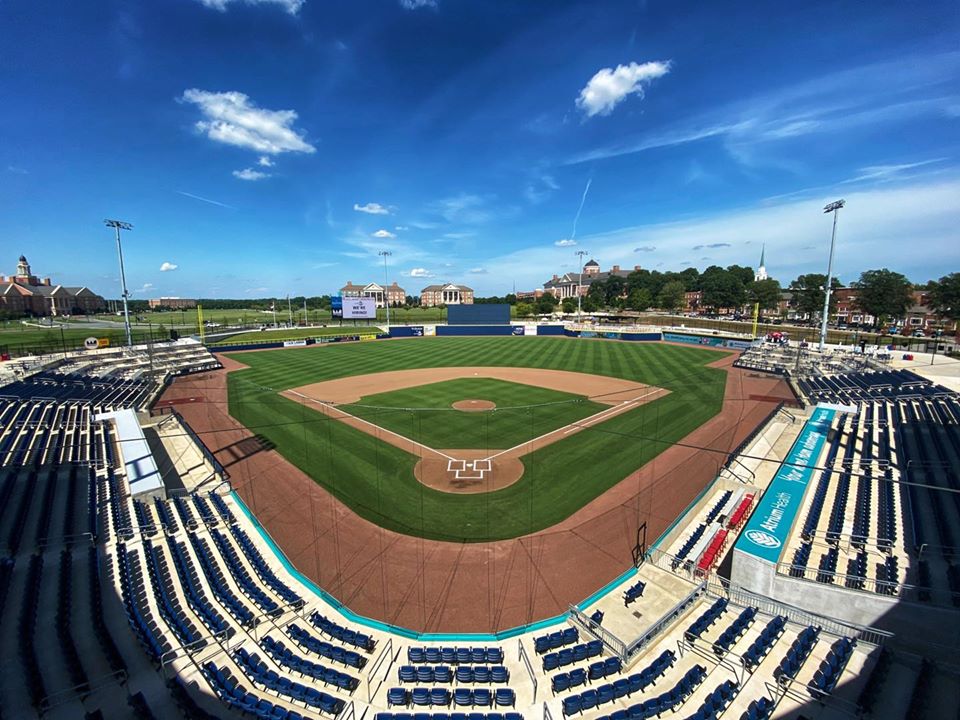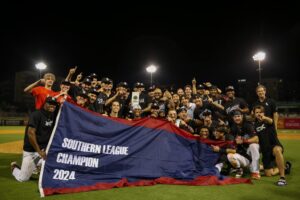The story of Kannapolis’ 2020: Hope reigns in lost season

Kannapolis’ minor league baseball franchise had put in a lot of work to reinvent itself in 2020. A new stadium (Atrium Health Ballpark). A new team name (Cannon Ballers from Intimidators).
Then, poof.
“With the MiLB business model, Kannapolis has done nothing but spend money since September of 2019. They were getting ready to open up the ballpark and expecting a huge financial windfall on opening day,” said Jeff Lantz, Senior Director, Communications, Minor League Baseball in a phone interview with FutureSox. “Then that and the entire season gets canceled. Teams are looking at 19 months of zero revenue. I can’t think of any business model that is built to sustain that.”
As bleak as that statement sounds, the team, the community and the players are making the best of a bad situation. This three-part series looks at the impact the cancellation of the Minor League Baseball season has on each of them. FutureSox talked to seven people connected with Kannapolis Cannon Ballers, the Low-A affiliate of the White Sox, and the city of Kannapolis for this series.
The Team
“Losing a year of revenue will have a lasting impact,” Kannapolis general manager Matt Millward told FutureSox in a phone interview. “We’re in a fortunate situation with the new ballpark and the new brand. Nearly all of our season ticket holders believe in our long-term vision. The investments that they made this season will be used for future seasons. It handcuffs you because the revenue stream came in prior to the season. We won’t see that prior to next year. Season ticket holders have already committed. The lead up to next year, our first source of revenue, new season ticket sales, new sponsorship sales and individual tickets won’t be there. Times are tough right now, with very little revenue coming in. We are fortunate with the new brand, the new ballpark.”
The team has been able to capitalize on the new ballpark by generating food and beverage revenue.
“Atrium Health Ballpark is also considered a city park so daily from noon to 7 p.m. Boomer’s Bistro is open for takeout food,” Millward said. “We’ve got standard ballpark fare available every day and then Thursdays through Sundays we ramp up our operation a little bit more. We’ve got a salsa and nacho cart, hand-dipped ice cream, and we’ve opened up our right field bar, which has been popular. We just started a few weeks ago, but having Thirsty Thursdays has been a nice boost for us. It’s stopped the bleeding.”
“I’m turning into a food and beverage worker, a bartender and cook,” Kannapolis radio broadcaster and baseball operations manager Trevor Wilt said. “It is fun because we’re positively impacting the community, but it’s a tough blow and still is.”

“In minor league baseball,” Wilt said, “It’s all about the fun and the entertainment and the impact you make on the community. And we were ready to make that positive impact on the community, and we still are. But we’re just doing it without baseball.”
The concession stand opening to the public has been a hit for the Cannon Ballers.
“When we entered Phase 2, the team opened up a concession stand. The response has been awesome,” city of Kannapolis director of communications Annette Privette Keller said via email. “Hundreds of people each day are eating concessions (appropriate social distancing is observed). We are averaging 600-700 daily and 1400 on the weekends – purchasing food.”
Selling ballpark food hasn’t been the only thing that has been popular.
“Our merchandise operation has been incredible,” Millward said. “Our logo is very minor league baseball. Americana, red, white, and blue colors, It’s attractive to all generations, and it screams fun, and that’s what we’re all about.”
The Fans
While the loss of the season hurts, the merchandise sales and food offerings are being well received by the fan base.
“It’s a destination even without baseball,” booster club leader Debby Smith said. “I’m going there with a couple of people who are not fans for Taco Thursday tonight. So it’s drawing people in who are not there for baseball, but who want to be part of the community and the downtown.
“The concession stand, the fan stores, it‘s a pleasure to be there. We’ll enjoy it a whole lot more when there are games on the field. We are seeing a growth in enthusiasm with the renamed team and the ballpark. The booster club has grown, in spite of the fact, there are no games. That’s a sign of the enthusiasm and the support that is to come.”
The Losses Count
Despite these successes, the timing of the pandemic and ensuing shutdown was devastating for what the Cannon Ballers had planned for 2020.
“It was definitely disappointing,” Millward said. “It couldn’t have happened at a worse time. I’ll never forget the date of March 11. That was the date everything hit full force, and the buzz was at its height. Our season ticket holders had selected their seats. We had plans to put our individual tickets on sale. It was unfortunate because the buzz was at its highest. The staff was going 100 mph for 6-8 months leading up to it and then having to pause. We’re doing our best to keep that momentum going, and I would say we’re building on it.”
The numbers facing minor league teams across the country are daunting.
“On average Milb teams bring on $5.4 million a year,” Lantz said. “Almost 70% of it is spent on payroll, promotional items and all the bills that go along with running an organization.
“Where it’s really going to hurt these teams is the marketing end of it. Say a local business has a season ticket package, an outfield fence sign, and suite rental night. The package could be worth $12,000 total. The team is going to give them the same thing next year, creating another hole in revenue. This is going to have an impact on our teams for 2-3 years down the road.”
“Look at jobs. Our season staff would have been 100-plus, so all those seasonal jobs were lost,” Millward said. “It’s really difficult for our staff, our sales people to even look ahead to next year when we don’t even know when we’ll get a fall schedule. It’s going to be interesting to see how it all unfolds.
“All the restaurants and bars that are close to our stadiums. All the ushers and ticket takers that count on that part-time revenue aren’t getting that money now. The local business-to-business relationships. The businesses that provide the beer, the food, all those local businesses are missing out as well.”
Focusing on the positives
“A bright spot has been the fact that ballpark was built as a public park,” Keller said. “We quietly opened the doors, and people have ‘discovered’ the ballpark. The concourse and restrooms are open to walkers, bicyclists, runners and those who just want to sit in the stands and read a book. It has been amazing to see people exercising and eating at the ballpark. It has helped us all as a community to have some sense of normalcy.”
“Our quote to the staff the last few weeks is the best is yet to come,” Millward said. “All we can do is stay positive and keep our thoughts moving forward.”
Perhaps, Keller summed it up best: “But – that being said, we cannot wait for the first pitch next year!”
How can anyone disagree?
Want to know right away when we publish a new article? Type your email address in the box on the right-side bar (or at the bottom on a mobile device) and click “create subscription.” Our list is completely spam free, and you can opt out at any time. Also, consider supporting FutureSox on Patreon! You can get early access to special articles and Patreon-only posts, in addition to more benefits.







Looks like you have an amazing Booster club with an enthusiastic leader in Debby Smith.